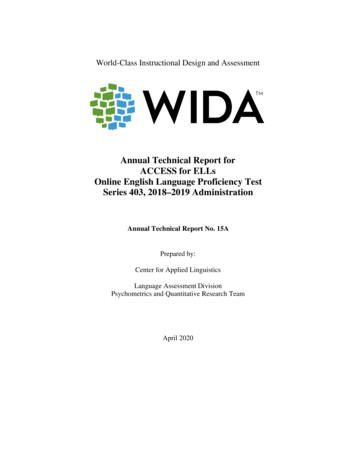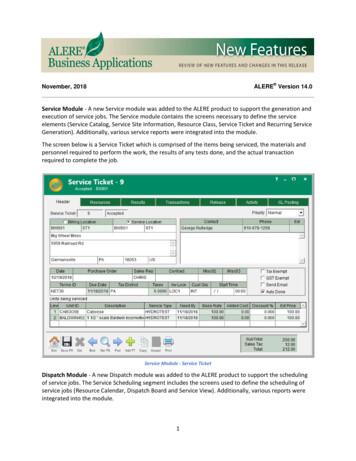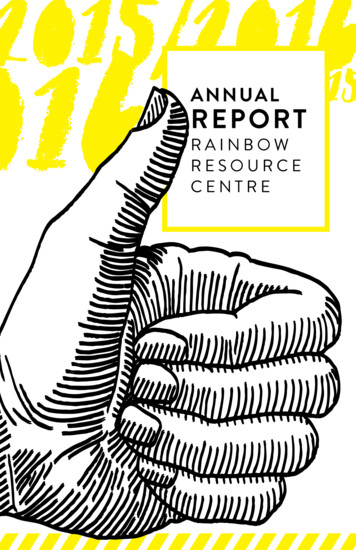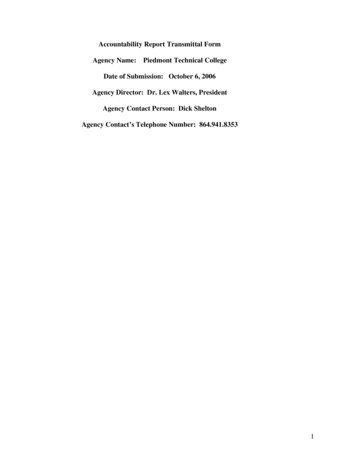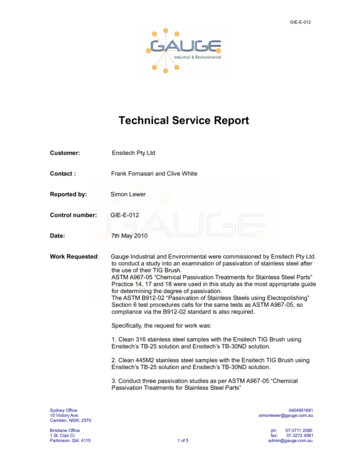
Transcription
GIE-E-012Technical Service ReportCustomer:Ensitech Pty LtdContact :Frank Fornasari and Clive WhiteReported by:Simon LewerControl number:GIE-E-012Date:7th May 2010Work Requested:Gauge Industrial and Environmental were commissioned by Ensitech Pty Ltd.to conduct a study into an examination of passivation of stainless steel afterthe use of their TIG Brush.ASTM A967-05 “Chemical Passivation Treatments for Stainless Steel Parts”Practice 14, 17 and 18 were used in this study as the most appropriate guidefor determining the degree of passivation.The ASTM B912-02 “Passivation of Stainless Steels using Electopolishing”Section 6 test procedures calls for the same tests as ASTM A967-05, socompliance via the B912-02 standard is also required.Specifically, the request for work was:1. Clean 316 stainless steel samples with the Ensitech TIG Brush usingEnsitech’s TB-25 solution and Ensitech’s TB-30ND solution.2. Clean 445M2 stainless steel samples with the Ensitech TIG Brush usingEnsitech’s TB-25 solution and Ensitech’s TB-30ND solution.3. Conduct three passivation studies as per ASTM A967-05 “ChemicalPassivation Treatments for Stainless Steel Parts”Sydney Office10 Victory Ave.Camden, NSW, 25700404951681simonlewer@gauge.com.auBrisbane Office1 St. Clair Cl.Parkinson, Qld. 4115ph:07-3711 2080fax:07-3272 4581admin@gauge.com.au1 of 5
GIE-E-012Method:1. The TIG Brush was used as per manufacturers on the 3B setting throughoutthis study.2. The method of cleaning was as per Ensitech’s instruction which includedsaturating the tip with the chosen cleaning solution and contacting the tip of thebrush on the area to be cleaned.3. To eliminate contamination, the brush was triple rinsed in deionised waterbetween each sample.4. The batches of TB-25 and TB30ND solutions were both manufactured inFebruary 2010 and samples of production batches and presented complete forthis study.5. Samples of 316 and 445M2 stainless steel were supplied by Ensitech. Thewelded samples were TIG welded.6. Both welded and unwelded samples were treated and subsequently tested.7. All treatments were performed in triplicate.8. 316 samples were tested for passivation as per ASTM A967-05 PotassiumFerricyanide-Nitric acid test. The method was followed including the making ofthe Potassium Ferricyanide –Nitric acid solution on the day of testing. A ferroussulphate spike was added to a blank piece of 316 stainless steel acting as apositive control. A very dark blue reaction product resulted as expected.9. 445M2 samples were tested for passivation as per ASTM A967-05 CopperSulphate talWater otal33333318Potassium FerricyanideNitric acid33333318Copper Sulphate33333318Table 1: Sample Type and Numbers of SamplesWater Immersion Test ASTM A967-05 Section 14. Practice ASydney Office10 Victory Ave.Camden, NSW, 25700404951681simonlewer@gauge.com.auBrisbane Office1 St. Clair Cl.Parkinson, Qld. 4115ph:07-3711 2080fax:07-3272 4581admin@gauge.com.au2 of 5
GIE-E-012Potassium ferricyanide-Nitric acid Test ASTM A967-05 Section 14.Practice E.Copper sulphate ASTM A967-05 Section 14. Practice 0NDWater Immersion-,-,-,-,-,-, , , -,-,-,-,-Potassium ferricyanideNitric acid-,-,-,-,-,-, , , ,-, , , -,-,-,-,-Copper sulphate-,-,-,-,-,-, , , -,-,-,-,-Table 2: Results of Passivation Testing (triplicates)Key: - no reaction/no sign of corrosion or staining a reaction /positive observation of corrosion or staining Number of indicates evidence of corrosion or staining (where is high)See examples of test samples following:Figure 1: 445M2 samples after 20 cycle Water Immersion TestNote the absence of corrosion (orange colouring) in both TIG Brush treated samplescompared to the untreated sample in the centre with obvious corrosion.Sydney Office10 Victory Ave.Camden, NSW, 25700404951681simonlewer@gauge.com.auBrisbane Office1 St. Clair Cl.Parkinson, Qld. 4115ph:07-3711 2080fax:07-3272 4581admin@gauge.com.au3 of 5
GIE-E-012Figure 2: Comparison of 316 samples after Potassium ferricyanide-Nitric acid Test.Note the positive blue colouration of the uncleaned weld sample compared to noblue colouration on both samples cleaned with the TIG Brush usingTB-25 and TB-30NDFigure 3: 445M2 Stainless Steel. Comparison between Treated and Untreatedsample in the Copper Sulphate Test. No copper colouration was observedin any of the samples treated with the TIG Brush with TB-25 and TB-30NDSydney Office10 Victory Ave.Camden, NSW, 25700404951681simonlewer@gauge.com.auBrisbane Office1 St. Clair Cl.Parkinson, Qld. 4115ph:07-3711 2080fax:07-3272 4581admin@gauge.com.au4 of 5
GIE-E-012Results Explained: All unwelded samples showed NO evidence of corrosion or staining in any test. Thiswas true for samples uncleaned or cleaned with the TIG Brush. Welding of the 316 samples compromised its ability to resist corrosion. This wasshown by signs of corrosion in the water immersion test and also strong positives forfree iron in the Potassium ferricyanide-Nitric acid test. All welded 316 samples cleaned with the TIG Brush and TB-25 or TB-30ND showedno signs of corrosion in the water immersion test and negative results for free iron inthe Potassium ferricyanide-Nitric acid test. Welding of the 445M2 samples compromised its ability to resist corrosion. This wasshown by signs of corrosion in the water immersion test and also strong positives forfree iron in the Copper sulphate test. All welded 445M2 samples cleaned with the TIG Brush and TB-25 or TB-30NDshowed no signs of corrosion in the water immersion test and negative results for freeiron in the Copper sulphate test.Conclusions:Welding of stainless steel is an operation that reduces the material’s ability to resist corrosion. This isdue to the disruption of the passivating dense chromium oxide layer and creation of a surface oxidelayer which contains iron and is non resistant to oxygen penetration which allows the continuingcorrosion of the weld. The removal of iron in the surface layer passivates the weld and returns thematerial to an equivalent corrosion resistance to that of unwelded stainless steel.This study determined that the use of the TIG Brush as per Ensitech’s use recommendations witheither TB-25 or TB-30ND solutions provide effective passivation of both 316 and 445M2 stainlesssteels as per three standard methods of ASTM A967-05 “Chemical Passivation Treatments forStainless Steel Parts, as well as complying with ASTM B912-02 “Passivation of Stainless Steelsusing Electopolishing” Section 6.References:ASTM A967-05 “Chemical Passivation Treatments for Stainless Steel Parts. ; ASTM InternationalASTM B912-02 “Passivation of Stainless Steels using Electopolishing” ; ASTM InternationalTechnical Guidelines on TIG Brush use for cleaning stainless steel. Ensitech Pty Ltd.END OF DOCUMENTSydney Office10 Victory Ave.Camden, NSW, 25700404951681simonlewer@gauge.com.auBrisbane Office1 St. Clair Cl.Parkinson, Qld. 4115ph:07-3711 2080fax:07-3272 4581admin@gauge.com.au5 of 5
ASTM A967-05 Chemical Passivation Treatments for Stainless Steel Parts Practice 14, 17 and 18 were used in this study as the most appropriate guide for determining the degree of passivation. The ASTM B912-02 Passivation of Stainless Steels using Electopolishing Section 6 test procedures calls for the same tests as ASTM A967-05, so

